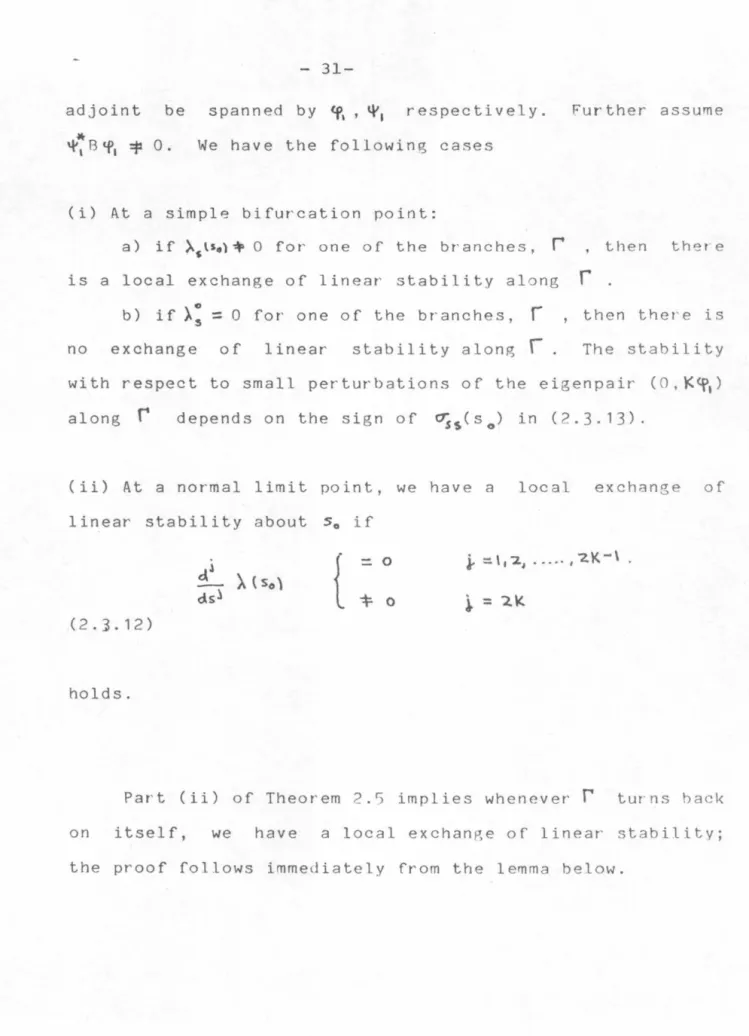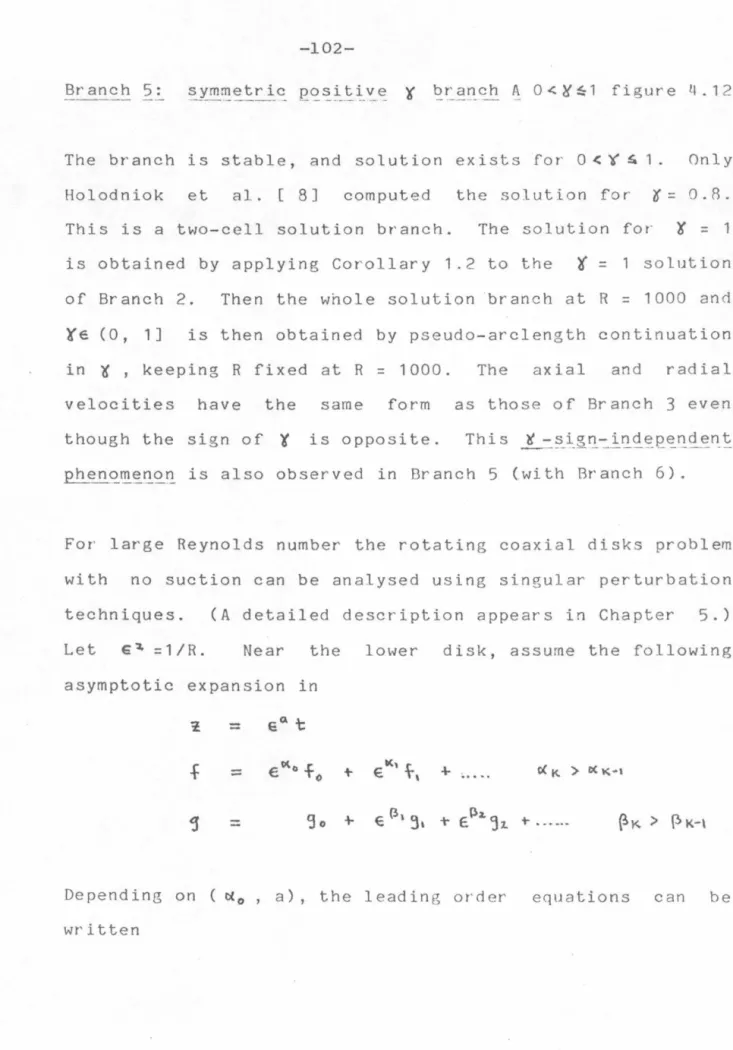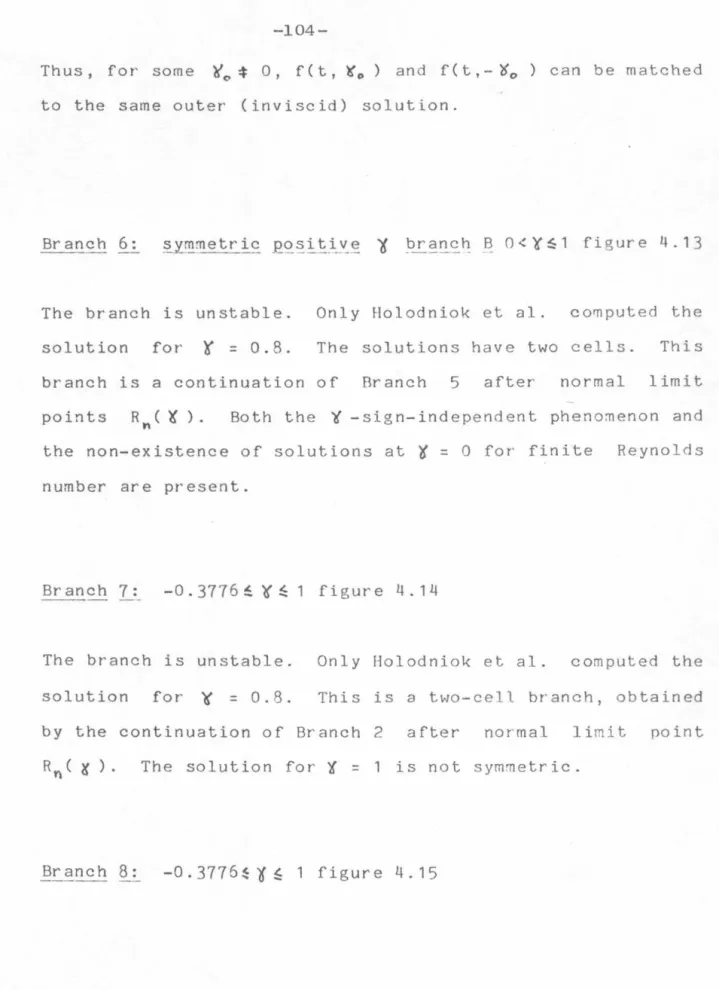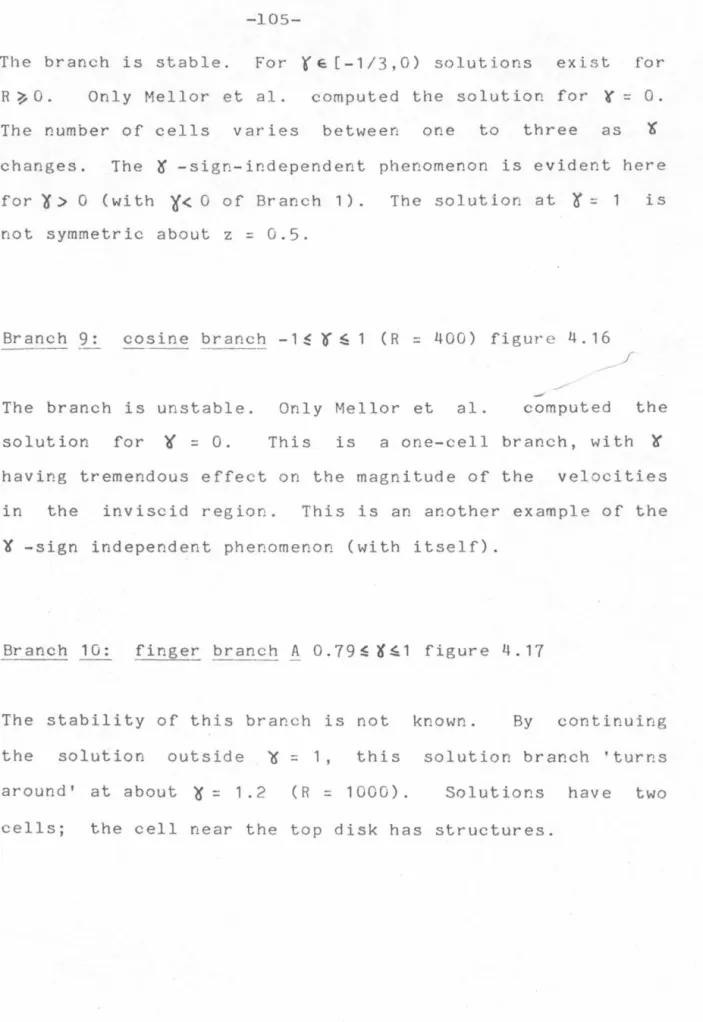Numerical approximations of non-unique solutions of the Navier-Stokes equations are obtained for steady viscous incompressible axisymmetric flow between two infinitely rotating coaxial disks. Among them: (i) Mellor·, Che1pple and Stokes in 1968 [22] calculated three different solutions when one of the discs is stationary, that is 't = 0, where 'I is defined as the ratio of the. angular velocity of upper disk to that of the lower disk;. li) In 1965 [23] Pearson solved the time-dependent problem and obtained two different steady-state solutions when. In this thesis we systematically calculate the many different solutions of the time-independent rotating coaxial disks problem without suction.
These include simple bifurcation in Section 1, pseudo-arclength continuation in Section 2 and the idea of local exchange of linearized stability in Section 3 (Keller [12], Crandall and Rabinowitz [4]). The upper and lower disks are allowed to rotate about the z-axis with angular velocities. Here ~ can be either the Reynolds number R or the ratio of the angular velocity of the two disks.
In this thesis we deal with two different kinds of critical points: simple bifurcation points and normal boundary points. For nonlinear two-point boundary value problems, an efficient calculation method for the coefficients (2. 1.11) will be given in the next chapter.

NORMAL LIMIT POINTS AND PSEUDO ARC-LENGTH CONTINUATION
We observe the difference between a normal limit point and a simple bifurcation point (Definition 2.2) is condition. Keller [13], we see that, solving the inflated system (2.1.1) together with (2.2.2), the branches of the solution contain only normal boundary points. Having found the equilibrium solutions of (2.1.1) we like to know about their stability as solutions to the corresponding time-dependent problem.
At a simple bifurcation point or a normal limit point, the null space of the operator G"' 0 is one-dimensional. We observe that there is a local exchange of linear stability with respect to the eigenpair (O,K~1 ) if. Let the null space of G: and its adjoint spans respectively Part (ii) of Theorem 2.5 implies that whenever r reverses itself, we have a local trade-off of the linear capability st;. We point out that the highest derivatives of w and u with respect to s evaluated at s become unique by ~9.l:!i__~~_:i:~g_ have no component of. We saw in Chapter 2 that the problem with normal boundary points can be circumvented by relaxing the parameter and introducing an additional equation with a new parameter s, the pseudo arc length parameter. We recall from Section 2 of Chapter 2 that ~ must be determined as part of the solution. Euler's one-step pseudo-arclength method can be used to obtain a predictor for the solution at (s0 + &s. For completeness we also derive the rate of convergence for regular solution points and simple bifurcation points for algorithm s. An extension of Newton's method for general systems of equations in which the Jacobians are singular at the solution points is shown. However, we note that in algebraic ei~envalue problems, inverse iteration is often used to compute the eigenvector corresponding to a simple eigenvalue. We now show that the solution of (3.3.9) at a normal limit point is equivalent to one step of inverse iteration. The assumption that Newton's method converges implies that at each iteration the Jacobian ~atrix is G :. Using some form of pivoting strategy, the LU decomposition of c : c.1n can be converted into the. Since the zero of R is a simple eigenvalue of U0, we have simple eigenvalues from analytic perturbation theory. Normal limit points and simple bifurcation points are both singular points at which the operator G: is singular. Nevertheless, using the s-algorithm, we saw a quadratic Newton meter transformation for normal boundary points and a linear one for bifurcation points. However this should not be a surprise due to the necessary and sufficient conditions of Lemma 2. 3. By 'inflating' the system for normal boundary points, we have constructed a projection operator which projects to .. ero the error fraction between iterations of Newton which vanishes only linearly. This result can be extended to solutions of general nonlinear systems of equations with the Jacobian having non-trivial zero spaces. For simple bifurcation points, let i, and '!:', be the n11ll vector and its adjoint of the inflated matrix. For higher dimensional null spaces, Theorem ).3 can be extended by computing all the independent null vectors and their adjoint, In this section we describe multiple solutions computed using the analysis and methods of the last two chapters. In some of the branches of the solution, the axial and radial velocities for some positive ~ are approximately the same as those for negative )( and we explain this sign-independent ~ phenomenon using the standard. In the problem of rotating coaxial disks we have available for continued in one of two parameters: the Reynolds number R or the angular velocity ratio of the two disks ~ All branches of the solution are calculated using a systematic approach; no smart initial guesses are needed. From these solutions, we let the Reynolds number R be the continuation parameter and use our pseudo-arc length continuation for fixed YK = -1 + k( 0.1 ), k = 0.1,. a) The determinant of the converged dithered Jacobian. The determinant of the discretized linearized operator has the asymptotic expansion. for the centered-Euler method). The solutions for negative ~ obtained above give half of the curve E ~ F when we use our pseudo-arc length continuation procedure or. As we approach from the middle of the lips towards the tips C, D, the two normal border points merge into one and then disappear as we pass the tips. The normal boundary point curve GHI touches the left side of the lip CHD at H. This is the second of the four branches that has no solution for '( = 0 at finite R. The above similar solutions of imply the axial and radial velocities have the same solution to leading order regardless of the sign of t. This is a two-cell branch, obtained by continuing branch 2 after the normal boundary point Rn ( 1!( ) • The solution for ' l = is not symmetric In this section we explain the calculations at and near critical points: (1) Bifurcation points, (2) Normal boundary points, and (3) Fusion of normal boundary points. For Y = -1, the determinant of the converged discretized Jacobian has a sign change between R = 110 and R = 120. Neck splitting, the critical point R e is located, with the determinant of the discretized Jaqobian very small. The coefficients (ah, b~, ch) of the simple bifurcation equation are calculated and the tangent vectors C~o. The solution of the algebraic bifurcation equation has the property that any constant multiplication ( ~0 , ~l) is also a solution. Let a be a function in the normalization equation. derivation of the parameter according to s. We then perform an exchange of linear stability calculations and obtain (1) the "middle" of the s-curve is unstable, (2) the "head" and "t a i l" of the s-curve are stable. In the last section we show some new perturbation constructions for large-amplitude solutions (see Chapter 4). Some of the leading order equations above will be used to construct some of our calculated solutions. We note that the boundary layer equations are nonlinear and no closed-form solution has yet been found. From the analysis of McLeod and Parter [21] we can assume that the solution I of Dij~stra and Zandbergen [S] will be used to fit the invisible outer solution. As in the construction of Stewartson's solution, we use a two-layer model and restrict our studies to the closed interval [0, 0.5]. The invisible region has solution which is 0(1) since the leading order Equations in the boundary layer region are the same as in Section 5.2. We note that this is a consequence of the fact that the coefficients· multiplying the higher derivatives in (5.3.9) vanish at z = 0.5 if we accept the rotationally singular solution and the linear operator 1 becomes singular.). Given that this inviscid solution must agree with the numerical solution of the von Karman boundary layer equations (5.1.3). We will then consider the boundary layer equations and show how to match its solutions to those from the inviscid region. For fitting the function f, Tam [29] noted that the zeroth-order term of the invisible expansion corresponds to the first-order term of the boundary layer expansion, and that the first-order term of the invisible expansion corresponds to the zeroth-order term of the boundary layer This can be done because of the Burmann-Teixeira theorem in complex variable theory (see Whittaker and Watson [31]). Third, the many different boundary layer - invisible extensions, some of which are listed in Section 5.1, and the removal of the. Fourth, the sign-independent behavior of y in Chapter 4 can give us further insight into construction analysis. In Gaussian flow of 1 im in at ion, round-off error will, in general, be present. When x is stored in the machine, i t is rounded to x~ and can be represented. Because we are interested in 'capturing' the largest element in the submatrix, we see that this cyclic search is
CHAPTER 3
COMPUTATION OF SOLUTION BRANCHES CONTAINING LIMIT POINTS
CHAPTER 4

CHAPTER 5

